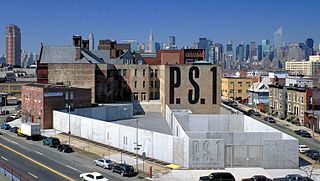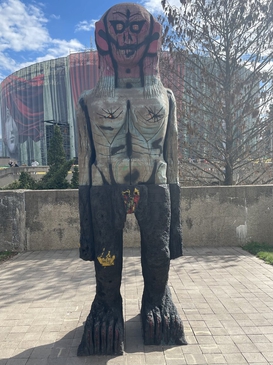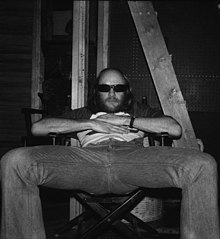
Adolph Friedrich Reinhardt was an abstract painter active in New York for more than three decades. He was a member of the American Abstract Artists (AAA) and part of the movement centered on the Betty Parsons Gallery that became known as abstract expressionism. He was also a member of The Club, the meeting place for the New York School abstract expressionist artists during the 1940s and 1950s. He wrote and lectured extensively on art and was a major influence on conceptual art, minimal art and monochrome painting. Most famous for his "black" or "ultimate" paintings, he claimed to be painting the "last paintings" that anyone can paint. He believed in a philosophy of art he called Art-as-Art and used his writing and satirical cartoons to advocate for abstract art and against what he described as "the disreputable practices of artists-as-artists".

Vija Celmins is a Latvian American visual artist best known for photo-realistic paintings and drawings of natural environments and phenomena such as the ocean, spider webs, star fields, and rocks. Her earlier work included pop sculptures and monochromatic representational paintings. Based in New York City, she has been the subject of over forty solo exhibitions since 1965, and major retrospectives at the Museum of Modern Art, Whitney Museum of American Art, Los Angeles County Museum of Art, San Francisco Museum of Modern Art, Institute of Contemporary Arts, London and the Centre Pompidou, Paris.

MoMA PS1 is a contemporary art institution located in Court Square in the Long Island City neighborhood in the borough of Queens, New York City, United States. In addition to its exhibitions, the institution organizes the Sunday Sessions performance series, the Warm Up summer music series, and the Young Architects Program with the Museum of Modern Art. MoMA PS1 has been affiliated with the Museum of Modern Art since January 2000 and, as of 2013, attracts about 200,000 visitors a year.

Amy Sillman is a New York-based visual artist, known for process-based paintings that move between abstraction and figuration, and engage nontraditional media including animation, zines and installation. Her work draws upon art historical tropes, particularly postwar American gestural painting, as both influences and foils; she engages feminist critiques of the discourses of mastery, genius and power in order to introduce qualities such as humor, awkwardness, self-deprecation, affect and doubt into her practice. Profiles in The New York Times, ARTnews, Frieze, and Interview, characterize Sillman as championing "the relevance of painting" and "a reinvigorated mode of abstraction reclaiming the potency of active brushwork and visible gestures." Critic Phyllis Tuchman described Sillman as "an inventive abstractionist" whose "messy, multivalent, lively" art "reframes long-held notions regarding the look and emotional character of abstraction."

Huma Bhabha is a Pakistani-American sculptor based in Poughkeepsie, New York. Known for her uniquely grotesque, figurative forms that often appear dissected or dismembered, Bhabha often uses found materials in her sculptures, including styrofoam, cork, rubber, paper, wire, and clay. She occasionally incorporates objects given to her by other people into her artwork. Many of these sculptures are also cast in bronze. She is equally prolific in her works on paper, creating vivid pastel drawings, eerie photographic collages, and haunting print editions.

Shirazeh Houshiary is an Iranian-born English sculptor, installation artist, and painter. She lives and works in London.
Phong H. Bui is an artist, writer, independent curator, and Co-Founder and Artistic Director of The Brooklyn Rail, a free monthly arts, culture, and politics journal. Bui was named one of the "100 Most Influential People in Brooklyn Culture" by Brooklyn Magazine in 2014. In 2015, The New York Observer called him a "ringmaster" of the "Kings County art world." Bui was the recipient of the 2021 American Academy of Arts and Letters Award for Distinguished Service to the Arts. He lives in Greenpoint, Brooklyn.
Rirkrit Tiravanija is a Thai contemporary artist residing in New York City, Berlin, and Chiangmai, Thailand. He was born in Buenos Aires, Argentina in 1961. His installations often take the form of stages or rooms for sharing meals, cooking, reading or playing music; architecture or structures for living and socializing are a core element in his work.
Peter Ford Young is an American painter. He is primarily known for his abstract paintings that have been widely exhibited in the United States and in Europe since the 1960s. His work is associated with Minimal Art, Post-minimalism, and Lyrical Abstraction. Young has participated in more than a hundred group exhibitions and he has had more than forty solo exhibitions in important contemporary art galleries throughout his career. He currently lives in Bisbee, Arizona.
Ron Gorchov was an American artist. He was known for his colorful, abstract paintings on curved canvases.
Nina Kuo is an Asian American painter, photographer, sculptor, author, video artist and activist who lives and works in New York City. Her work examines the role of women, feminism and identity in Asian-American art. Kuo has worked in partnership with the artist Lorin Roser. Kuo has been described as being a pioneer of Chinese American art.
Juan Sánchez, also Juan Sanchez is an American artist and educator. He is an important Nuyorican cultural figure to emerge in the second half of the 20th century. His works include photography, paintings and mixed media works.

Mary Miss is an American artist and designer. Her work has crossed boundaries between architecture, landscape architecture, engineering and urban design. Her installations are collaborative in nature: she has worked with scientists, historians, designers, and public administrators. She is primarily interested in how to engage the public in decoding their surrounding environment.
Clifford Owens is an African-American mixed media and performance artist, writer and curator. Owens was born in Baltimore, Maryland, in 1971 and spent his early life in Baltimore. Owens is known for his works which center on the body and often include interactions with the audience and spontaneity.
Kevin Beasley is an American artist working in sculpture, performance art, and sound installation. He lives and works in New York City. Beasley was included in the Whitney Museum of American Art's Biennial in 2014 and MoMA PS1's Greater New York exhibition in 2015.

Carol Haerer (1933-2002) was an American artist known for abstract painting in the vein of Minimalism and Lyrical abstraction.

Joanna Pousette-Dart is an American abstract artist, based in New York City. She is best known for her distinctive shaped-canvas paintings, which typically consist of two or three stacked, curved-edge planes whose arrangements—from slightly precarious to nested—convey a sense of momentary balance with the potential to rock, tilt or slip. She overlays the planes with meandering, variable arabesque lines that delineate interior shapes and contours, often echoing the curves of the supports. Her work draws on diverse inspirations, including the landscapes of the American Southwest, Islamic, Mozarabic and Catalan art, Chinese landscape painting and calligraphy, and Mayan art, as well as early and mid-20th-century modernism. Critic John Yau writes that her shaped canvasses explore "the meeting place between abstraction and landscape, quietly expanding on the work of predecessors", through a combination of personal geometry and linear structure that creates "a sense of constant and latent movement."
Ryan Ponder McNamara is an American artist known for fusing dance, theater, and history into situation-specific, collaborative performances. McNamara has held performances and exhibitions at Art Basel, The High Line, Dallas Symphony Orchestra, The Whitney Museum, MoMA P.S.1, and The Kitchen amongst other places.

Harriet Korman is an American abstract painter based in New York City, who first gained attention in the early 1970s. She is known for work that embraces improvisation and experimentation within a framework of self-imposed limitations that include simplicity of means, purity of color, and a strict rejection of allusion, illusion, naturalistic light and space, or other translations of reality. Writer John Yau describes Korman as "a pure abstract artist, one who doesn’t rely on a visual hook, cultural association, or anything that smacks of essentialization or the spiritual," a position he suggests few post-Warhol painters have taken. While Korman's work may suggest early twentieth-century abstraction, critics such as Roberta Smith locate its roots among a cohort of early-1970s women artists who sought to reinvent painting using strategies from Process Art, then most associated with sculpture, installation art and performance. Since the 1990s, critics and curators have championed this early work as unjustifiably neglected by a male-dominated 1970s art market and deserving of rediscovery.

Robert Yasuda is an American abstract painter, most known for contemplative, atmospheric works that straddle painting, sculpture and architecture. He first attracted wide attention in the 1970s for large wall works merging painting and installation art, mounted at MoMA PS1, the Corcoran Museum of Art, and Museum of Contemporary Art, Chicago. Since the 1990s, he has focused on paintings that disrupt conventional formats using hand-carved wood panels and custom framing elements, upon which he builds multi-layered iridescent surfaces that respond dynamically to shifting conditions of light, time and vantage. Reviewing this later work, ARTnews critic Barbara MacAdam described Yasuda as a "romantic minimalist" whose paintings present an intangible, fleeting reality that is nonetheless referential, showing his roots in their construction, shifting tones and titles.











